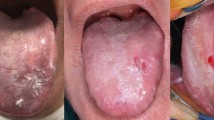Abstract
Introduction
Over the past 15 years, dysplastic oral mucosal lesions have been treated by laser ablation with variable success. A recent study have shown that the type of laser utilized may be important for patient outcome, however, it may also be changes at a cellular level that could be an important factor in determining recurrence outcome. The aims of this study were to assess cellular markers related to oral dysplastic lesions treated by two different laser types.
Methods and Materials
Twenty patients with a histopathological diagnosis of dysplasia treated with laser ablation between the years 1992 and 2003 were assessed. Tissue blocks of the original diagnostic biopsy specimens were stained with specific cell cycle markers (Cyclin-D1 and Ki67) via immunohistochemistry and presence of the marker were analysed by virtual microscopy. Patients were assessed according to grade of dysplasia [(mild vs. moderate vs. severe) and the type of laser used (Potassium Titanyl Phosphate (KTP) vs. Carbon Dioxide (CO2)].
Results
No significant difference in Cyclin-D1 and Ki67 levels were found between the two groups with different grades of dysplasia, however, decreased Cyclin-D1 was found in those patients treated with KTP laser (P = 0.028).
Conclusions
The findings of the present study may indicate cell cycle makers such as Cyclin-D1, may be responsible for the behaviour of dysplastic lesions treated with laser therapy, rather than the type of laser itself, which was reported in previous studies.



Similar content being viewed by others
References
Abbas N, El-Sharkawy S, Abbas E, El-Shaer M (2007) Immunohistochemical study of p53 and angiogenesis in benign and preneoplastic oral lesions and oral squamous cell carcinoma. Oral Surg Oral Med Oral Pathol Oral Radiol Endod 103:385–390
Petersen PE (2009) Oral cancer prevention and control—the approach of the world health organisation. Oral Oncol 45:454–460
Yokoo K, Noma H, Inoue T, Hashimoto S, Shimono M (2004) Cell proliferation and tumour suppressor gene expression in iodine unstained area surrounding oral squamous cell carcinoma. Int J Oral Maxillofac Surgery 33:75–83
Hamadah O, Thomson PJ (2009) Factors affecting carbon dioxide laser treatment for oral precancer: a patient cohort study. Lasers Surg Med 41:17–25
Thomson P, Hamadah O, Goodson ML, Cragg N, Booth C (2008) Predicting recurrence after oral precancer treatment: use of cell cycle analysis. Br J Oral Maxillofac Surg 46:370–375
Saito T, Nakajima T, Mogi K (1999) Immunohistochemical analysis of cell cycle-associated proteins p16, pRb, p53, p27 and ki-67 in oral cancer and precancer with special reference to verrucous carcinomas. J Oral Pathol Med 28:226–232
Kramer IR, Lucas RB, Pindborg JJ, Sobin LH (1978) Definition of leukoplakia and related lesions: an aid to studies on oral precancer. Oral Surg Oral Med Oral Pathol 46:518–539
Liu SC, Klein-Szanto AJ (2000) Markers of proliferation in normal and leukoplakia oral epithelia. Oral Oncol 36:145–151
Lazzaro B, Cleveland D (2000) P-53 and Ki-67 antigen expression in small oral biopsy specimens of salivary gland tumours. Oral Surg Oral Med Oral Pathol Oral Radiol Endod 89:613–617
Takeda T, Sugihara K, Hirayam Y et al (2006) Immunohistological evaluation of Ki-67, p63, CK 19 and p53 expression in oral epithelial dysplasias. J Oral Pathol Med 35:369–375
Chrysomali E, Nikitakis NG, Tosios K, Sauk JJ, Papanicolaou SI (2003) Immunohistochemical evaluation of cell proliferation antigen Ki-67 and apoptosis-related proteins Bcl-2 and caspase-3 in oral granular cell tumour. Oral Surg Oral Med Oral Pathol Oral Radiol Endod 96:566–572
Wiesner FG, Magener A, Fasching PA et al (2009) Ki-67 as a prognostic molecular marker in routine clinical use in breast cancer patients. Breast 18:135–141
Lodi G, Porter S (2008) Management of potentially malignant disorders: evidence and critique. J Oral Pathol Med 37:63–69
Pitiyage G, Tilakaratne W, Tavassoli M, Warnakulasuriya S (2009) Molecular markers in oral epithelial dysplasia: review. J Oral Pathol Med 38:737–752
Van der Waal I (2009) Potentially malignant disorders of the oral and oropharyngeal mucosa; terminology, classification and present concepts of management. Oral Oncol 45:317–323
Schwartz F, Maraki D, Yalcinkaya S et al (2005) Cytologic and DNA cytometric follow-up of oral leukoplakia after CO2 − and Er:YAG-laser assisted ablation: a pilot study. Lasers Surg Med 37:29–36
Lim B, Smith A, Chandu A (2010) Treatment of oral leukoplakia with carbon dioxide and potassium-titanyl-phosphate lasers: a comparison. J Oral Maxillofac Surg 68:597–601
Chandu A, Smith A (2005) The use of CO2 laser in the treatment of oral white patches: outcomes and factors affecting recurrence. Int J Oral Maxillofac Surg 34:396–400
Mishra R, Das B (2009) Cyclin D1 expression and its possible regulation in chewing tobacco mediated oral squamous cell carcinoma progression. Arch Oral Biol 54:917–923
Acknowledgments
This project was supported by the Australian Dental Research Foundation Undergraduate Vacation Research Grant 2008/2009.
Conflict of interest
The authors declare that they have no conflict of interest.
Author information
Authors and Affiliations
Corresponding author
Rights and permissions
About this article
Cite this article
Lo, J., McNaughtan, J., Rani, V. et al. An Immunohistochemical Analysis of Cell Cycle Markers in Oral Mucosal Dysplastic Lesions Treated by Laser Therapy. A Pilot Study. J. Maxillofac. Oral Surg. 10, 190–194 (2011). https://doi.org/10.1007/s12663-011-0211-3
Received:
Accepted:
Published:
Issue Date:
DOI: https://doi.org/10.1007/s12663-011-0211-3




